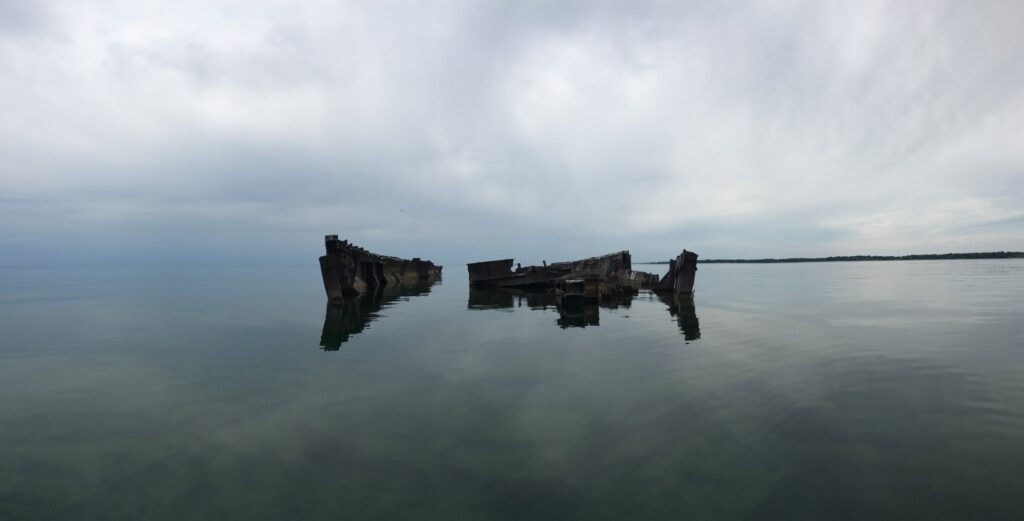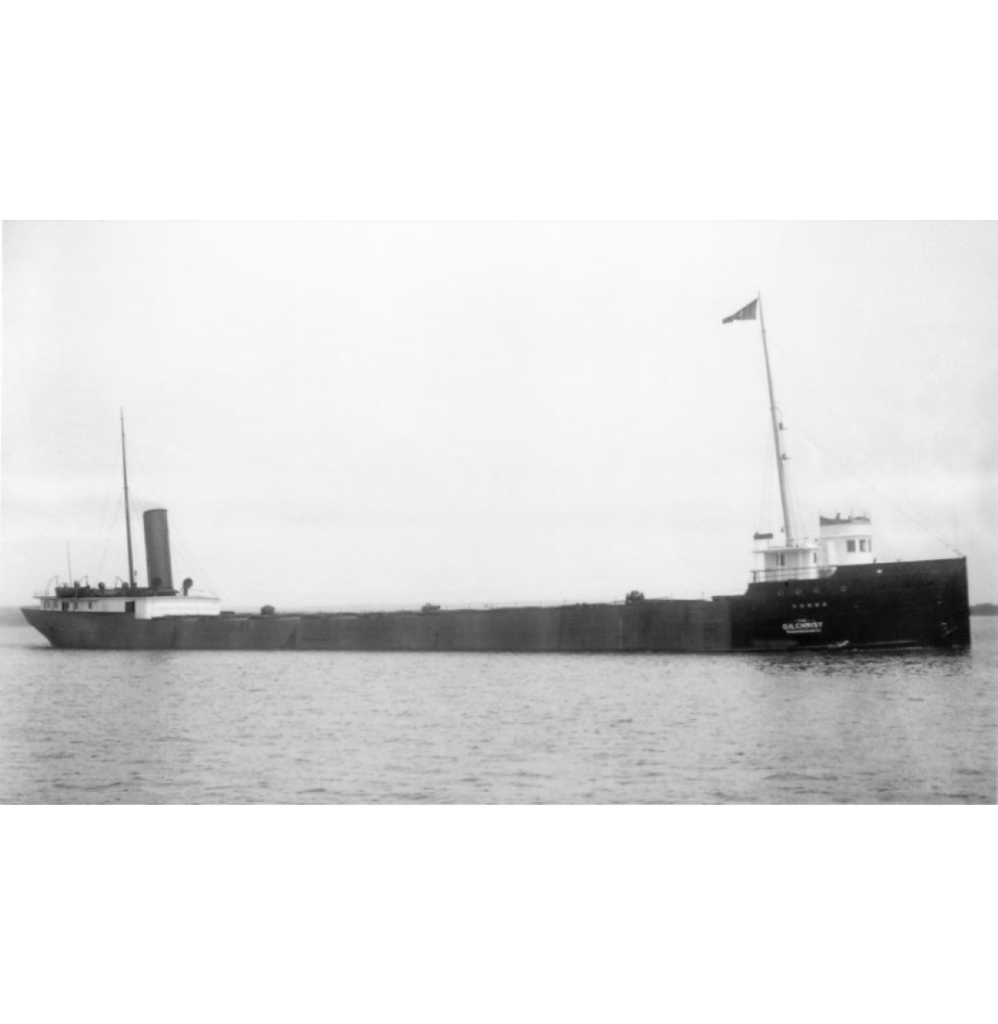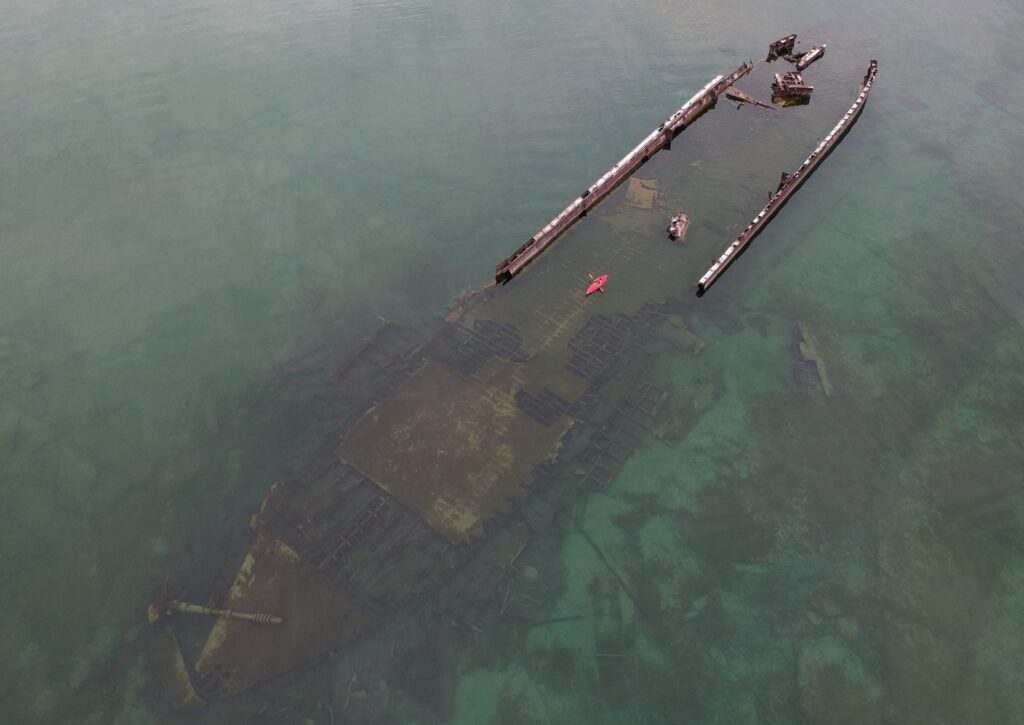Found just east of the City of Port Colborne, on the shallow shores of Lake Erie is the wreck of the SS Steel Products. The ship’s previous name, Venus may have been more original, but no matter what it is called, this ill-fated ship has become a distinguished landmark in the area and a popular spot for local paddlers, snorkelers, and windsurfers. While the partial steel hull is all that remains above water this is only the tip of the iceberg, as the crystal-clear waters also provide visitors with spectacular views of what remains below the surface. The ship’s enormous size is outlined by the now, mostly submerged, steel hull, and just below the surface old gears, chains, and even the ship’s propeller can be seen.
The ship, which ran aground after it broke its anchor lines while waiting to be salvaged in nearby Port Colborne, is a testament to the shipping and salvage industry that still exists in the city today. The wreck is one of the hundreds that can be found in Lake Erie, but its proximity to the shore and the clear surrounding waters makes this a must-visit location for paddlers, snorkelers, and adventure enthusiasts.

The Ship
The ship was launched on February 28, 1901. It was built as a bulk cargo ship by the American Ship Building Company in Lorain, Ohio. It was built for the Globe Steamship Company which later merged to form the Gilchrist Transportation Company, where the ship was christened as the Venus and based out of Cleveland, Ohio. The ship was the most recent addition to the company’s fleet, each ship named after a planet in the solar system.
The Venus was 105.5 meters long, 14.6 meters wide, and had a depth of 8.5 meters giving it a gross tonnage of 3,719 tonnes. To give the ship power, it was fitted with a triple expansion 1,480 horsepower, single-shaft engine which could move the ship along at a speed of 11 knots.
The Venus was operated by Gilchrist Transportation for only 9 years before the fleet went into receivership forcing the company to sell it off. In 1913, it was sold alongside Gilchrist’s sixteen other ships in an auction to a consortium of firms including the Lackawanna Steamship Company, Acme Steamship Company, Standard Steamship Company, Provident Steamship Company and the Huron Barge Company. After the purchase, the consortium renamed itself the Interlake Steamship Company. The firm and its current fleet of ships can still be found operating on the Great Lakes today.
After being purchased, Venus operated for the Interlake Steamship Company for almost 30 years. Several modifications were made during this time including in 1915 when the ship’s cargo hold was rebuilt and in 1927 when two revolving cranes were added to the ship by the Toledo Ship Building Company.
In 1941, Venus was sold again, this time to the American steel making company, Bethlehem Steel. This company operated the ship out of Buffalo until 1958 when it was once again sold to Steel Products Steamship Company. Along with the addition of new cabins and a new smokestack, the company also gave the ship a new name, the S.S. Steel Products. The newly named ship transported scrap metal for a few years, but its age and increasing need for repairs lead the company to sell the ship just three years later.




It was purchased by Marine Salvage Limited of Port Colborne who intended to tow it to the city to be scrapped. But the ship was not going to give up so easily and on October 26, 1961, it broke its tow lines (some sources say it broke its anchor) and eventually ran aground in the shallow waters on the west side of Point Abino. The company decided it was still worth partially salvaging and hired a crew to stay on the ship throughout the winter to ensure it remained upright and in its current position. In the spring of 1962, a 500-meter gravel road was constructed from the lake shore to the ship which allowed trucks and heavy machinery to access it. Over the next several years, Harry Gamble of Port Dover scrapped the ship’s superstructure, engines, and upper parts of the steel hull.
What remained after the operation finished was the bottom portion of the hull about a meter above the waterline and several pieces of the ship’s engine/equipment that were left behind.
About the Area
The wreck now lies approximately 450 meters from shore. While part of the hull can still be seen rising from the water, most of it has slipped below the waves as the result of nearly 50 years of wave action and lake ice. But while the northeast shore of Lake Erie is known for its turbulent, wind-swept waters on the occasional calm day, the remaining section of the ship not above water can be seen below the waterline. Crystal clear water and a nearby, accessible beach also make the ship a fantastic place for swimmers and snorkelers looking for an unforgettable experience.

The scale of how much was salvaged becomes clear once you reached the ship. Even at low water levels, it is possible to paddle through the now, mostly empty hull. Parts of the rusting steel hull and several large metal gears are all that is left of the ship that can be seen above the water. Below the water is a different story. Sitting in depths of 0.5 meters to 2/3 meters, is the clear steel outline of the ship along with the chains to its forward anchors, steel gears, and even its rear propeller and driveshaft.
While it is more than exciting to explore the wreck from the water, to grasp the size of the ship it is best experienced from the air, where the silhouette of the ship is clearly seen. This is also the best way to see the gravel road that was built for the ship to aid in the salvaging operation. Travelling from the ship’s left side, northward to the lake shore is the faint trace of this boulder-lined road.
Sources & Further Exploring
Alpena County George N. Fletcher Public Library (n.d.). VENUS (1901, Bulk Freighter). Northeast Michigan Oral History and Historic Photograph Archive: Alpena, Michigan, Retrieved from https://www.nemoha.org/3717618/data.
Bowling Green State University (n.d.). Venus. Historical Collections of the Great Lakes. Retrieved from https://greatlakes.bgsu.edu/item/440425.
Dowling, E.J. (1961, September). The Big Splash. Telescope: September 1961, Vol. 10, No. 8. Great Lakes Maritime Institute: Detroit, MI. Retrieved from https://images.maritimehistoryofthegreatlakes.ca/images/MHGL0001219441T.PDF.
Great Lakes Vessel History (n.d.). Venus 1. Greatlakesvesselhistory.com. Retrieved from https://www.greatlakesvesselhistory.com/histories-by-name/v/venus-1.
Reef Warriors (2014, August 23). The History of the Sherkston Wreck. Reefwarriors.wordpress.com. Retrieved from https://reefwarriors.wordpress.com/2014/08/23/the-history-of-the-sherkston-wreck/.
Wreck Site (n.d.). SS Steel Products (+1961). WreckSite.eu. Retrieved from https://wrecksite.eu/wreck.aspx?208058.